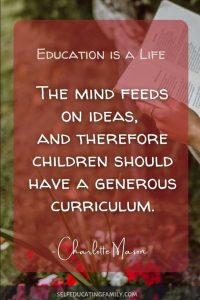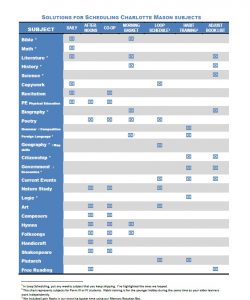
Evaluating Your Charlotte Mason Homeschooling
November 3, 2022When I started with Charlotte Mason (CM) homeschooling, I have to admit, I was a bit overwhelmed. Twenty years later, I wish I knew then what I know now. Whether you are a veteran or a novice homeschooler, it’s good to take a step back to evaluate how your homeschool plan is going. Here are some tips that I’ve learned to keep your homeschool year on track with Charlotte Mason homeschooling.
Remember: Method vs. Curriculum
In her “20 Principles” from the preface of Towards a Philosophy of Education, Volume 6 of the Charlotte Mason Series, Charlotte Mason says, “In saying that ‘education is a life,’ the need of intellectual and moral as well as of physical sustenance is implied. The mind feeds on ideas, and therefore children should have a generous curriculum.”
This “generous curriculum” sometimes translates into more than 15 subjects being covered as early as the elementary years. It can get overwhelming. First, let’s remind ourselves that Charlotte Mason homeschooling is a method, not a curriculum.
What? But I Have a Curriculum That Says It’s Charlotte Mason!
It’s a great question – and I know because I used the most popular free CM curriculum out there. It’s a fantastic curriculum. But I wanted to complete ALL of it.
- Two Great CM general curriculums out there:
- Ambleside Online says that “AmblesideOnline is a free homeschool curriculum that uses Charlotte Mason’s classically-based principles to prepare children for a life of rich relationships with everything around them: God, humanity, and the natural world.”
- Simply Charlotte Mason boasts “An enjoyable and complete Charlotte Mason curriculum” with a focus on a six-year history cycle and teaching most subjects as a family.
- Also, there are lots of great single-subject curriculums that use CM methods, like:
- Our Journey Westward: No Sweat Nature Study series
- Sabbath Mood Homeschool: Living Science series
Really, there are so many more lovely curriculums. These few I mentioned are by no means an exhaustive list. The issue is not about the curriculum. The underlying methods and principles are what makes Charlotte Mason-style homeschooling.
Problems When You Get Bogged Down in Curriculum
Here are some common problems when you think a particular curriculum is going to be the answer to all your issues.
- It’s too much. Especially true for those new to Charlotte Mason homeschooling, we see a list of 15+ subjects that “have” to be taught! Multiplied by the number of children in the house! In my first years of homeschooling with these methods, I would often cut back to the “basics” and skip everything else. It was a bit discouraging. But the reality was that I didn’t understand the methods and principles at first.
- Too much pressure with so many subjects. Following the curriculum without using the principles can make you feel pressured. In the beginning, I constantly felt like I was doing it “wrong” because I could never finish the list!
- A key idea of “Short lessons” can become an issue. For example, I had 20 minutes a day scheduled for 2nd-grade math for my twins. What if it takes you 20 minutes just to get your math materials out? I’m not saying that it ALWAYS took us a ridiculous amount of time to shift subjects, but it was noticeable at first.
- What if there is never time for “fun” subjects? This made me sad. The so-called “extra” subjects are actually the key part of making a generous and full curriculum.
- What about the demanding years – if you have toddlers or young learners in with your older learners? How can you help anyone if everyone is begging for your time?
Underlying Methods of Charlotte Mason Homeschooling
Learning how to homeschool with CM methods is key to keeping curriculum overwhelm under control.
Methods include the use of:
- Living books
- Short, varied lessons
- Narration
- Copywork and dictation
- Habit training
- Nature study
- No slipshod work – only quality work
- Building observation skills
- Building useful handicraft skills
- Building self-motivated learners
- Masterly inactivity
- Connections of all knowledge to an understanding of God
- Interestingly, even without this single fundamental thread that tied all of Charlotte Mason’s ideas together, the other methods work so well that non-religious homeschoolers can use CM methods very successfully.
My Experiences
Ironically, one underlying method that drew me to this method of homeschooling was “short lessons”. I had 3 boys under age 8 and short lessons seemed the way to go with active children and short attention spans. Yet when I tried it, I couldn’t pull it off at first.
In hindsight, of course, I had been trying to do much, too much with such young people. And I don’t mean that I had been trying to do too many subjects – I mean that I had been trying to “teach” and “lecture” too much. It’s time for Folk Song? Great. Here’s a brief lecture on the origin of I’ve Been Working on the Railroad and three theories of just who Dinah is.
NO! Just sing the song. End of lesson.
My controlling perfectionism was beginning to make my boys dependent on me rather than on themselves for learning. I needed “masterly inactivity”.
Masterly Inactivity
A quote from Charlotte Mason’s Volume 3, “We ought to do so much for our children, and are able to do so much for them, that we begin to think everything rests with us and that we should never intermit for a moment our conscious action on the young minds and hearts about us. Our endeavours become fussy and restless.”
Once I understood how to let fussiness and perfectionism go, and once we developed some better habits about the logistics of how we did lessons, formal lessons got much easier. Short and varied lessons became doable.
One homeschool mom I know summed it up when she said the light bulb went off in her head when a veteran mom told her, “Folk Song? It’s only 5 minutes!” All those little “extras” take so little time but are woven into your children’s lives in a rich curriculum when you use the methods and principles.
Why Is It So Hard To Allow Room For a Full Curriculum?
Due to my ideas about education coming from a public school background, I wanted to make sure I always covered the “essentials” of math, science, history, and English. It was sometimes hard to leave the afternoon open.

So we often had a hard time incorporating those subjects that might be considered “non-core” – nature study, artist & composer study, Shakespeare, folk song, hymns, poetry, recitation, handicraft, and eventually Plutarch.
My advice to you is to guard the afternoon time as closely as you guard the morning time.
A Final Word
It’s easy to drop these so-called “extras” when you think they aren’t important, but they are actually vital to presenting the child with a wide and generous education.
I tried a number of solutions for fitting in all these wonderful pieces of a Charlotte Mason homeschooling curriculum. If you have trouble fitting the various subjects into your day, I’ve included a reference chart with Solutions for Scheduling Charlotte Mason Subjects.
More About the Author:
 Jean Rudd has been homeschooling her three sons since they were born. Trained in mechanical engineering, she has been a manufacturing engineer specializing in automation and process improvement, a technical writer and software trainer for proprietary systems, an instructional designer, and a web designer and trainer back when the internet was invented. For the past 20 years, she has been focusing on educating the next generation. She now blogs at Self Educating Family.
Jean Rudd has been homeschooling her three sons since they were born. Trained in mechanical engineering, she has been a manufacturing engineer specializing in automation and process improvement, a technical writer and software trainer for proprietary systems, an instructional designer, and a web designer and trainer back when the internet was invented. For the past 20 years, she has been focusing on educating the next generation. She now blogs at Self Educating Family.
Additional Homeschool Resources
How to Homeschool With the Charlotte Mason Method
A Charlotte Mason Approach to Math
Finding Your Homeschool Method with Sonya Shafer – PODCAST
Latest Posts

Guest Post by Gabriel Morse For several years, I sat for long hours every day behind one of those battleship gray desks in a windowless, dull, gray office. The pay was enough to take care…
Read more >
This post is sponsored by Little Monsters Universe. I'm Tina Salmanowitz, an advocate for homeschooling and science education. With over a decade of experience as a science educator (in class…
Read more >
This post is sponsored by Time4Learning. Before the pandemic, it was business as usual for Boca Raton resident Nikki Warris. Her two daughters, 5-year-old Natalie and 8-year-old Lexi were…
Read more >

